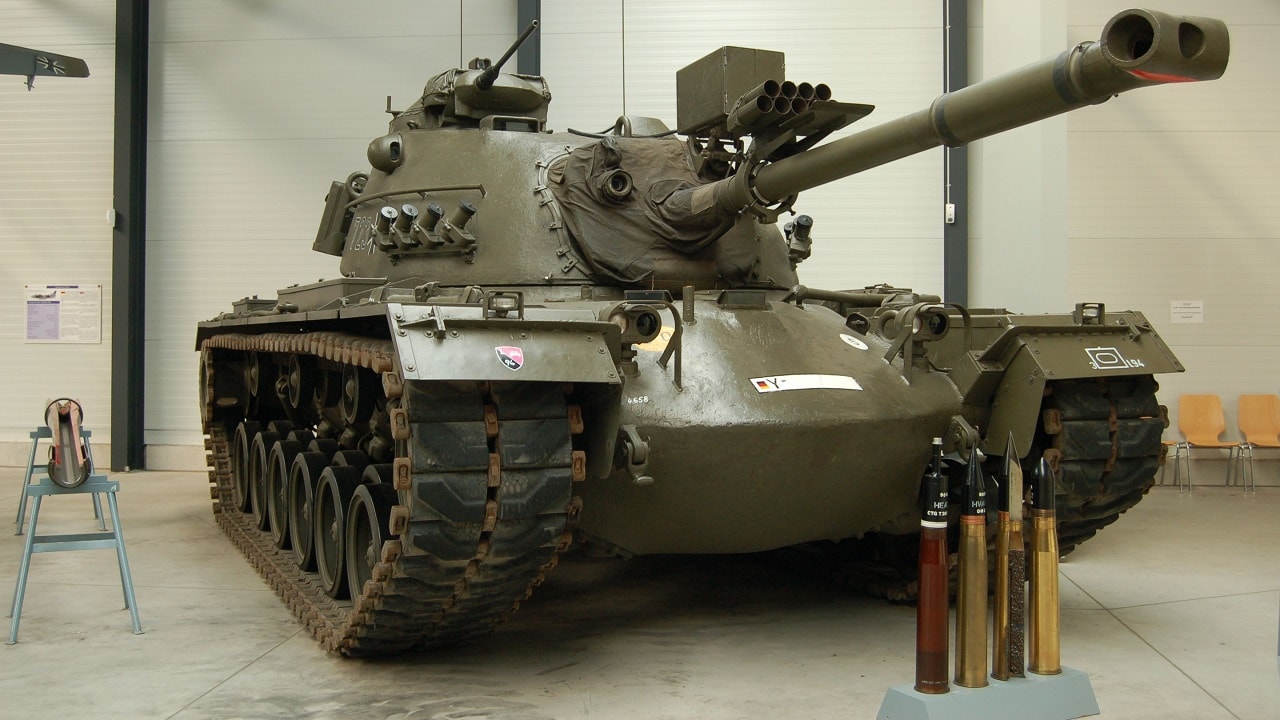Key Points and Summary on the M48 Patton Tank – Developed to counter the Soviet armored threat in the 1950s, the M48 Patton became a crucial American main battle tank during the Cold War.
-The mission of the tank was clear: beat the Russians in a war.
-While early gasoline-powered models were plagued by a limited range and a tendency to catch fire when hit, the later diesel versions became reliable workhorses.
-The M48 proved its mettle in combat, not with US forces in a major conflict, but with key allies like Israel, whose Patton crews famously outfought superior Syrian and Egyptian tanks in the 1967 and 1973 wars, cementing the tank’s formidable legacy.
M48 Patton Tank, A Needed Upgrade In The 1950s
The U.S. Army developed the M48 Patton tank in the early 1950s. It replaced the M-47 as the service’s main battle tank.
The Patton tank, named after the famed World War II general, was introduced in February 1952. The early Cold War-era MBT was designated as the 90mm Gun M48, Armored, Full-Tracked.
The M48 Patton was a good tank, especially for its time, and it was sorely needed. It was a significant improvement over previous American tanks and saw extensive service with the U.S. Army and Marine Corps, including during the Vietnam War.
While the M48 experienced some early issues with its gasoline engine and certain mechanical components, later diesel-powered versions addressed these problems, and the tank underwent numerous upgrades throughout its lifespan.
Meet The M48 Patton Main Battle Tank
Fighting in Europe during World War II made it clear that armored warfare would remain of vital importance for decades to come. The Soviets continued to produce new tanks and built a substantial numerical advantage over the U.S. and the West.
The M46/M47s were simply upgraded M26 Pershing tanks that were put into use at the end of the war. They needed to be replaced with a modern tank capable of duking it out with any Soviet armor that might cross friendly borders.
The M48 project began in 1950. The Army included a powerful T139 90mm main gun and installed an improved gasoline engine. The service then contracted with Chrysler Defense for the design and production of the new tank.
An upgraded, more powerful engine – the Continental AV-1790-5B gasoline engine – generated 704 brake horsepower and was coupled with the Allison CD-850-4A cross-drive transmission. Innovations such as composite applique panels made from fused silica glass provided additional armor to protect the hull and turret.
The tank weighed 49.5 tons and held a crew of four – a commander, gunner, loader, and driver.
In addition to its 90mm main gun, it had a .30-caliber machine gun and a.50-caliber machine gun. The main gun could fire a variety of ammunition types: armor piercing; high explosive anti-tank; anti-personnel; canister (pellets); and canister (flechettes).
The armor thickness ranged between 0.5 and 4.5 inches. The 810-horsepower engine carried 200 gallons of fuel and could produce a top speed of 28 miles per hour. However, it was a gas guzzler with a limited range of just 70 miles. Later upgrades replaced this engine, which had a propensity to catch fire and explode after being hit by a shell, with a diesel engine, and the range increased to more than 300 miles.
An outstanding page loaded with interior and exterior photos, as well as with diagrams of the key components of the M48 Patton, can be accessed here.
The M48 was the most iconic tank of the Vietnam War, during which it was used by the Marines and the Army.
Outside of the U.S., several allies equipped their armor units with M48s, including West Germany, Greece, Turkey, Spain, Pakistan, South Vietnam, Taiwan, and Israel.
Israeli M48s met Egypt’s and Syria’s Soviet-made tanks on the field of battle during the Six-Day War in 1967. The mobility and technical prowess of the M48A2s and M48A3s overshadowed the superior firepower of the IS-3s used by Egypt.
The Israeli M48s later faced Egyptian and Syrian tanks again during the 1973 Yom Kippur War and took part in some of the largest armored battles since World War II – especially along the Golan Heights, where vastly outnumbered Israeli armor held against Syrian and Jordanian tanks.
The Pakistani Army used M48s during two wars with India, in 1965 and 1971. In an interesting footnote, the Pakistanis used their M48s to rescue American Rangers and Delta Force members during the Battle of Mogadishu (better known as Black Hawk Down) in October 1993.
The M48 Patton was a very capable tank that played key roles during and after the Cold War. While its earlier models had their issues, continuous upgrades and versatility made the Patton a valuable asset for the U.S. military and its allies.
It was eventually replaced by the M60 tank, but its legacy as a reliable and effective main battle tank is well-deserved.
About the Author:
Steve Balestrieri is a National Security Columnist. He served as a US Army Special Forces NCO and Warrant Officer. In addition to writing on defense, he covers the NFL for PatsFans.com and is a member of the Pro Football Writers of America (PFWA). His work was regularly featured in many military publications.
Russia’s Bomber Forces
Tu-22M3: The Bomber Ukraine Hit With Drones










